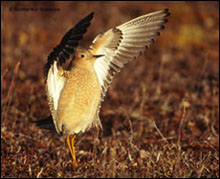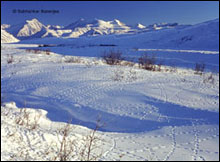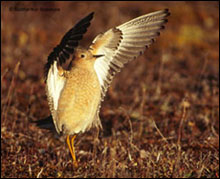Sun-drenched Pelican Island in Florida is about as far from the Arctic National Wildlife Refuge as you can get in the United States. At first blush, the 5,000-acre warm marsh would seem to have little connection to the 19 million-acre stretch of mountains and tundra. But they are inextricably linked.

A buff-breasted sandpiper.
© Subhankar Banerjee, from his book Arctic National Wildlife Refuge: Seasons of Life and Land.
As part of the National Wildlife Refuge System, both places provide migratory birds with habitat and sustain valuable wetlands. Both play historic roles in the development of refuge-based conservation. And both help maintain the natural integrity of our continent’s ecosystems.
In the controversy over whether petroleum development in the Arctic Refuge is worth the threat to habitat and wilderness, a crucial broader issue has been lost: how will drilling and development affect the 95 million-acre refuge system? Last month’s Senate vote to open the Arctic Refuge to drilling puts the already-patchy network in danger of unraveling — and it defies a protective statute Congress enacted just eight years ago.
Most people, when they imagine land that is wildly beautiful or teeming with animals, don’t think of wildlife refuges. Their thoughts might turn instead to places like the Grand Canyon, Yellowstone, Denali, or the Everglades — all national parks. Yet the National Wildlife Refuge System is an even larger, more diverse network of public lands, whose primary mission is protection of nature.
A little over 100 years ago, Teddy Roosevelt signed an order protecting Pelican Island as the first of these nature sanctuaries. At the time, a zoo-like vision of conservation prevailed, seeking protection of isolated wildlife enclaves. In the years since, the system has evolved from a jumble of unrelated preserves into an integrated web of habitat for protecting nature on a continental scale. For instance, beginning in the 1930s, the federal government began establishing refuges along flyways to sustain billions of migrating birds. By the 1990s, scientists understood the need to protect an interconnected network of healthy habitats. The refuges now host more than 250 imperiled species and 1.7 million acres of protected wetlands.

Ptarmigan tracks in the Okpilak River valley.
© Subhankar Banerjee, from his book Arctic National Wildlife Refuge: Seasons of Life and Land.
Eight years ago, Congress boosted the leadership role of this remarkable system in scientific nature protection: it charged the National Wildlife Refuge System with the goal of conserving healthy populations of plants and animals. The 1997 statute requires management that maintains “biological integrity, diversity, and environmental health.” This is, by far, the closest any federal public-land law has come to mandating ecological sustainability.
The great contemporary challenge for the refuge system became orchestrating scattered preserves for the goal of large-scale ecological protection. This is no easy task. But Congress sought to simplify that challenge by establishing a hierarchy of acceptable uses. Under the statute, which is implemented by the Department of the Interior, recreational uses must be compatible with the refuge system goals. And commercial development must be more than compatible; it must make affirmative contributions to the conservation mission. Otherwise, the risks that economic uses of individual refuges pose to the system could not be justified.
Now Congress is set to undermine the comprehensive framework for managing the refuge system that it established just eight years ago, and to establish a precedent for further damage to that statute.
For nearly a generation, the question of leasing oil in the Arctic Refuge has been a hardy perennial, sprouting regularly in proposed legislation. But to frame the debate solely in fiscal terms, or even in terms of allowable harm to this specific refuge, misses the mark. It turns the clock back to the days when we thought we could protect nature by saving isolated fragments.
Instead, drilling proponents ought to explain how petroleum development advances the conservation mission of the refuge system as a whole — or why the Arctic Refuge does not belong in this vital patchwork of environmental protection. To do less threatens not only this Alaskan landscape, but the entire system, and its historic contributions to the conservation gains of the past century.



